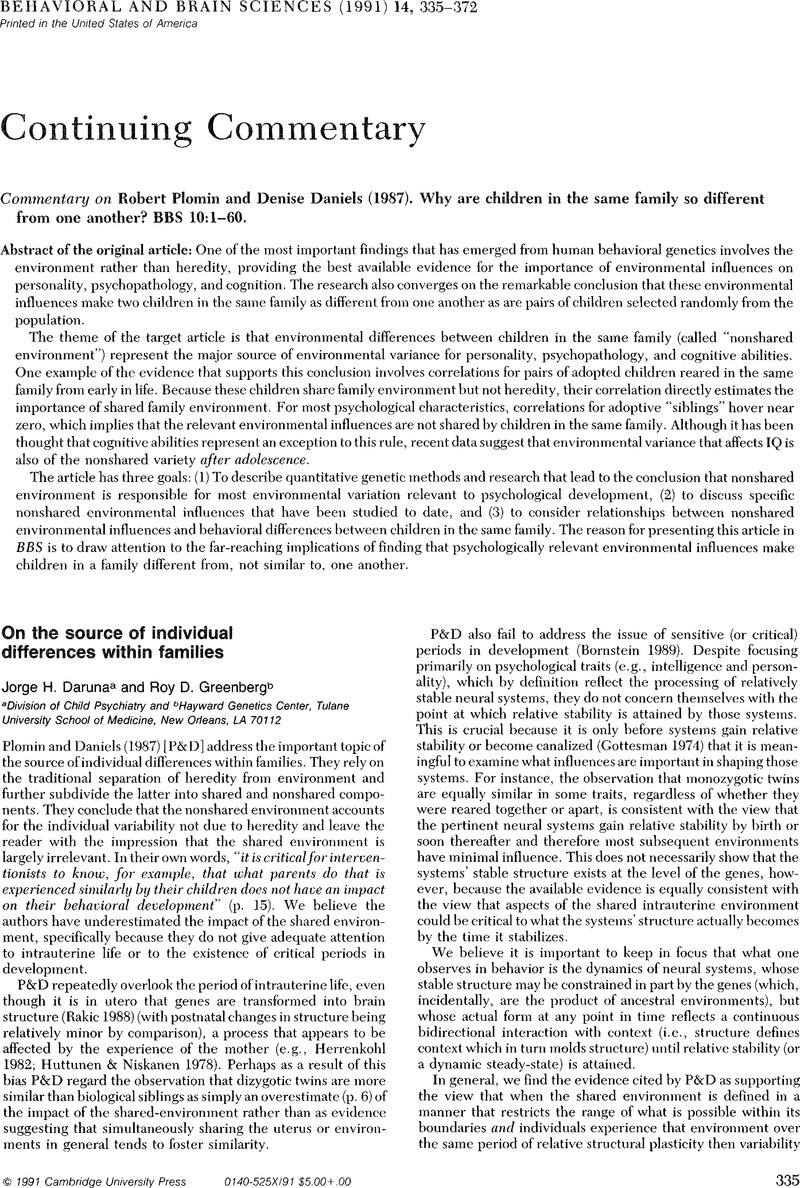No CrossRef data available.
Article contents
Why are adoptees so similar in IQ?
Published online by Cambridge University Press: 19 May 2011
Abstract
An abstract is not available for this content so a preview has been provided. Please use the Get access link above for information on how to access this content.

- Type
- Continuing Commentary
- Information
- Copyright
- Copyright © Cambridge University Press 1991
References
Bock, R. D. & Zimowski, M. F. (1987) Contributions of the biometrical approach to individual differences in personality measures. Behavioral and Brain Sciences 10:17–18. [RMD]Google Scholar
Boomsma, D. I. (1987) Absence or underestimation of shared environment? Behavioral and Brain Sciences 10:19–20. [RMD]Google Scholar
Bornstein, M. H. (1989) Sensitive periods in development: Structural characteristics and causal interpretations. Psychological Bulletin 104:179–97. [JHD]CrossRefGoogle Scholar
Bouchard, T. J. Jr. & McGue, M. (1981) Familial studies of intelligence: A review. Science 212:1055–59. [rRP]Google Scholar
Gottesman, I. I. (1974) Developmental genetics and ontogenetic psychology: Overdue detente and propositions from a matchmaker. In: Minnesota Symposium on Child Psychology, ed. Pick, A.. University of Minnesota Press. [JHD]Google Scholar
Herrenkohl, L. R. (1982) The anxiety-prone personality: Effects of prenatal stress on the infant. In: The Biology of Anxiety, ed. Matthew, R. J.. Brunner/Mazel. [JHD]Google Scholar
Horn, J. M., Loehlin, J. C. & Willerman, L. (1979). Intellectual resemblance among adoptive and biological relatives: The Texas adoption project. Behavior Genetics 9:177–208. [rRP]Google Scholar
Horn, J. M., Loehlin, J. C. & Willerman, L. (1982) Aspects of the inheritance of intellectual abilities. Behavior Genetics 12:479–516. [RMD]CrossRefGoogle ScholarPubMed
Huttunen, M. O. & Niskanen, P. (1978) Prenatal loss of father and psychiatric disorders. Archives of General Psychiatry 35:429–31. [JHD]CrossRefGoogle ScholarPubMed
Kamin, L. J. (1981) Commentary on Scarr & Weinberg (1978). In: Race, social class, and individual differences in IQ. Erlbaum. [RMD]Google Scholar
Kent, J. (1985) Genetic and environmental contributions to cognitive abilities as assessed by a telephone test battery. Unpublished doctoral dissertation, University of Colorado. [rRP]Google Scholar
Loehlin, J. C., Horn, J. M. & Willerman, L. (1989) Modeling IQ change: Evidence from the Texas Adoption Project. Child Development 60:993–1004. [rRP]CrossRefGoogle ScholarPubMed
Matarazzo, J. D. (1972) Wechsler's Measurement and Appraisal of Adult Intelligence. Williams & Wilkins. [RMD]Google Scholar
Olkin, I. & Pratt, [J. W.] (1958) Unbiased estimation of certain correlation coefficients. Annals of Mathematical Statistics 29:201–11. [RMD]Google Scholar
Plomin, R. (1988) The nature and nurture of cognitive abilities: In: Advances in the psychology of human intelligence, vol. 4. ed. Sternberg, R.. Erlbaum. [rRP]Google Scholar
Plomin, R. & Daniels, D. (1987a) Why are children in the same family so different from each other? Behavioral and Brain Sciences 10:1–16. [rRP]Google Scholar
Plomin, R. & Daniels, D. (1987b) Children in the same family are very different from each other, but why? Behavioral and Brain Sciences 10:44–54. [rRP]Google Scholar
Plomin, R., DeFries, J. C. & McCleam, G. E. (1990) Behavioral Genetics, 2nd ed. Freeman. [rRP]Google Scholar
Rakic, P. (1988) Specification of cerebral cortical areas. Science 241:170–76. [JHD]CrossRefGoogle ScholarPubMed
Rose, R. J. & Kaprio, J. (1987) Shared experience and similarity of personality: Positive data from Finnish and American twins. Behavioral and Brain Sciences 10:35–36. [RMD]Google Scholar
Scarr, S. & Weinberg, R. A. (1976) IQ test performance of black children adopted by white families. American Psychologist 31:726–39, also in Scarr (1981) 109–35, with discussion pp. 136–59, 469–74, 506–10, 515–18. [RMD]Google Scholar
Scarr, S. & Weinberg, R. A. (1978) The influence of “family background” on educational attainment. American Sociological Review 43:674–92; also in Scarr (1981) 357–383, with discussion pp. 384–398, 474–477, 504–506. [rRP, RMD]Google Scholar
Schiff, M., Duymé, M., Dumaret, A., Stewart, J., Tomkiewicz, S. & Feingold, J. (1978) Intellectual status of working-class children adopted early into upper-middle-class families. Science 200:1503–04. [RMD]CrossRefGoogle ScholarPubMed
Teasdale, T. W. & Owen, D. R. (1984) Heredity and familial environment in intelligence and educational level - A sibling study. Nature 309:620–22. [rRP, RMD]Google Scholar
Wachs, T. D. (1987) The relevance of the concept of nonshared environment to the study of environmental influences. A paradigmatic shift or just some gears slipping? Behavioral and Brain Sciences 10:41–42. [RMD]CrossRefGoogle Scholar


